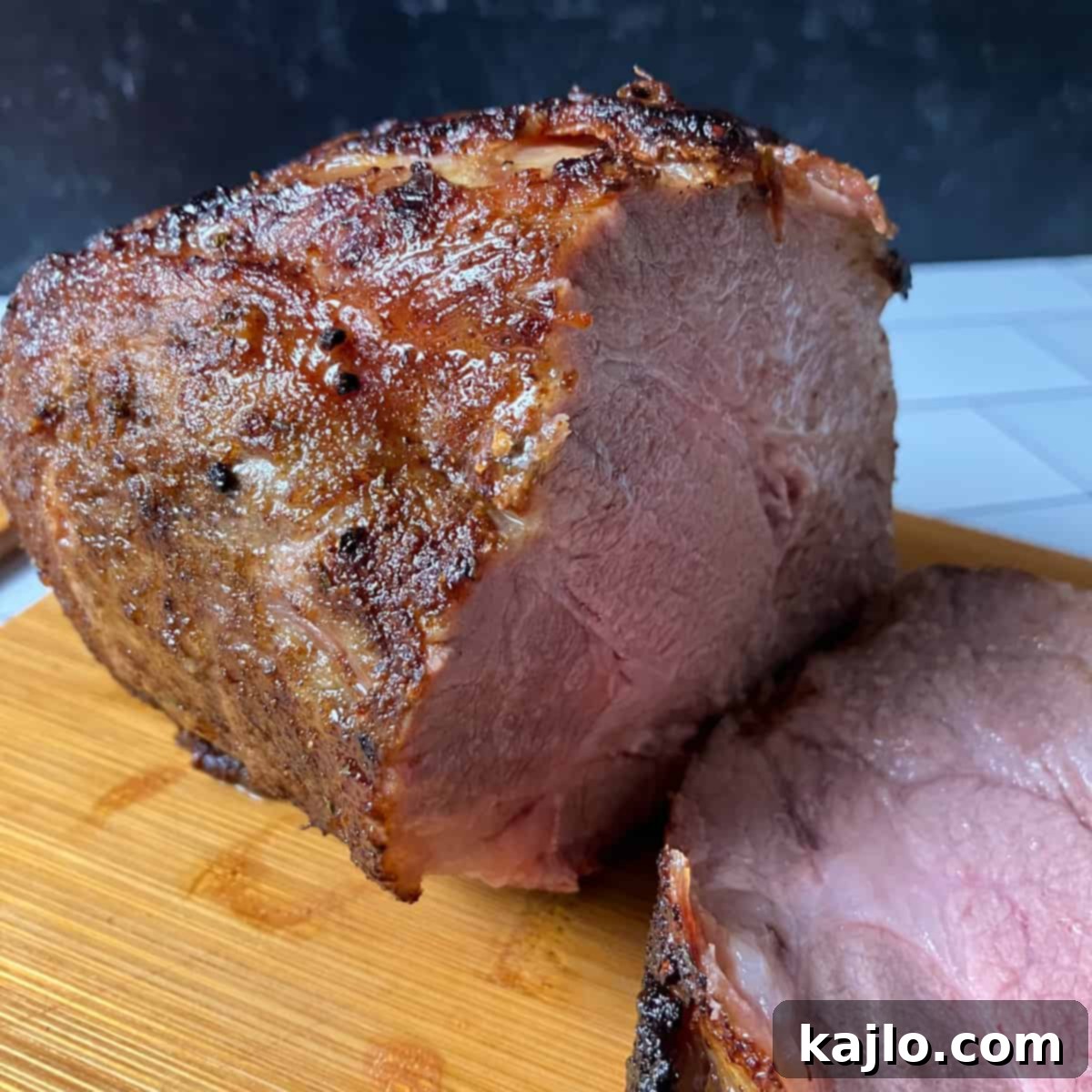Mastering Boston Butt: Your Ultimate Guide to Juicy Pork Shoulder Perfection
Unlock the secrets to cooking a truly mouthwatering Boston butt! This versatile and surprisingly inexpensive cut of pork transforms into incredibly moist and flavorful meals, perfect for any occasion. Whether you call it pork butt or pork shoulder, this comprehensive guide will walk you through everything you need to know: from understanding the cut and its rich history to seasoning techniques, our best Boston butt recipe, and expert tips for achieving culinary excellence. Discover how simple it is to create a show-stopping pork roast that will impress family and friends, ideal for a hearty Sunday dinner or a special holiday feast.
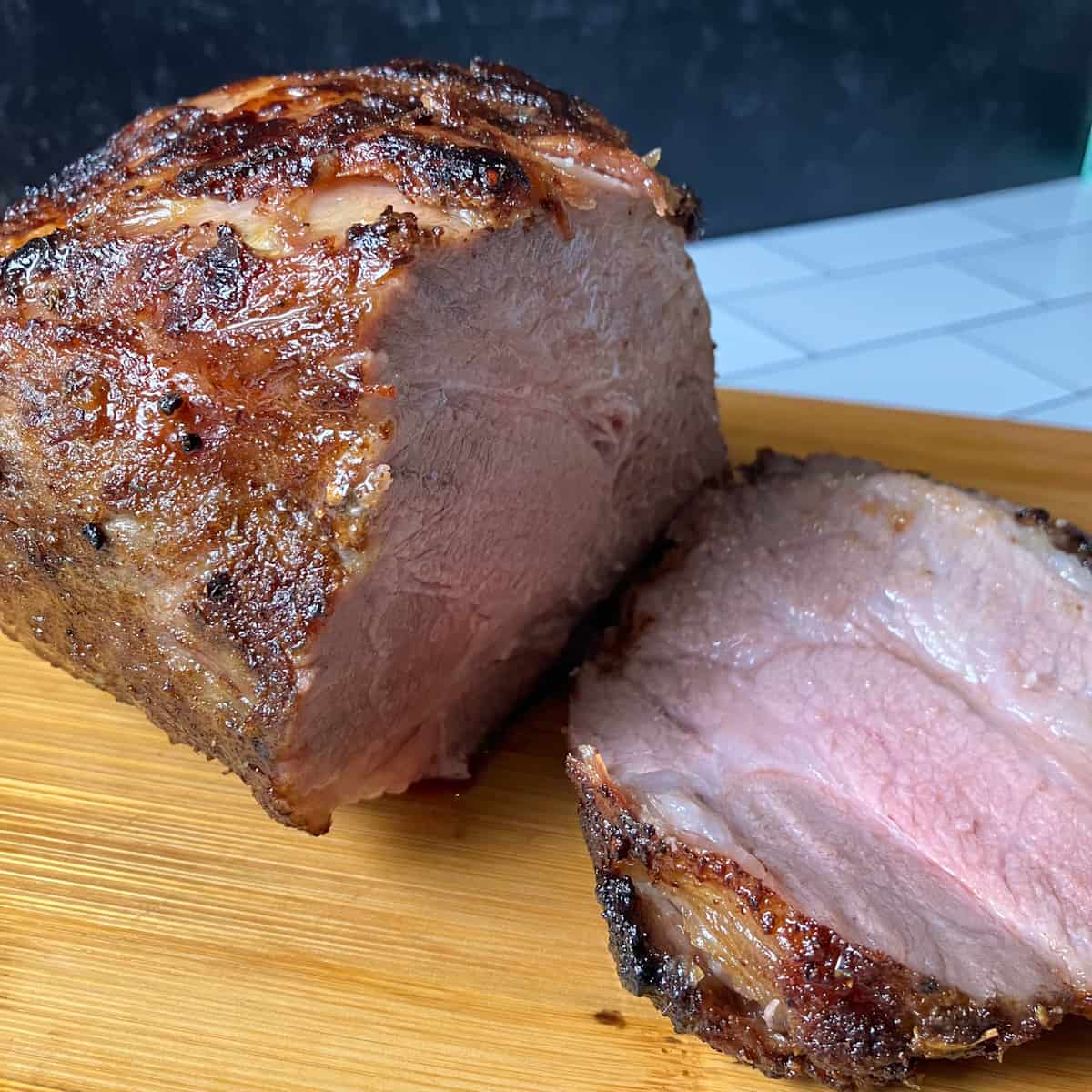
“Awesome recipe!”
– Pam, a happy home cook
🐷 What is a Boston Butt? Understanding This Flavorful Pork Cut
The Boston butt, also commonly known as pork butt or pork shoulder, is a rectangular cut of pork that comes from the upper part of the pig’s front leg. Specifically, it’s the section of the shoulder above the picnic ham (or arm roast). Despite its misleading name, it does not come from the rear end of the pig. This cut is highly prized for its generous marbling and connective tissue, which break down during slow cooking to yield incredibly tender, juicy, and flavorful meat. You can typically find it either bone-in, which includes the blade bone, or boneless, offering convenience for various recipes.
Why is it Called Boston Butt? A Historical Culinary Mystery
The intriguing name “Boston butt” sparks curiosity among many home cooks. While the cut doesn’t originate from the pig’s rear, its name has a few fascinating theories rooted in history and linguistics.
One popular theory, supported by sources like Southern Living, links the name to the colonial era in New England. During this time, this specific cut of pork was considered a regional specialty, particularly in Boston. It was often packed and shipped in large wooden barrels for storage and transport. These barrels were colloquially referred to as “butts.” Thus, the “Boston butt” became the name for the pork cut that was packed in these barrels from Boston.
Another theory, found on Wikipedia, suggests a linguistic origin. In Old English, the term “butt” could refer to the widest or thickest part of something. Given that the pork shoulder is a broad, thick cut, it’s plausible that “butt” referred to its physical characteristics rather than a barrel or its location on the animal.
Regardless of the exact origin, one thing is certain: the “Boston butt” is a beloved cut for its exceptional flavor and texture when slow-cooked, making its unique name a charming part of its culinary identity.
Boston Butt vs. Pork Butt: Is There a Difference?
In the culinary world, pork butt is simply another name for Boston butt. These terms are used interchangeably to refer to the same cut of meat. So, whether your recipe calls for “pork butt” or “Boston butt,” you’re looking for the same delicious and versatile pork shoulder cut from the pig’s front.
Does Boston Butt Have a Bone? Bone-in vs. Boneless Options
When purchasing Boston butt, you’ll typically find two options: bone-in and boneless. The choice between a boneless Boston butt pork roast and a bone-in Boston butt often comes down to personal preference and the specific recipe you’re preparing. Bone-in cuts often impart a richer flavor and can help keep the meat moist during long cooking times. However, boneless cuts offer greater convenience for carving, shredding, and faster preparation. Both varieties will yield excellent results when cooked properly, so feel free to choose what suits your cooking style best.
Is Boston Butt Beef or Pork? Clarifying the Animal Source
To clear up any confusion, Boston butt is definitively a cut of pork. It comes from a pig, not a cow. If you’re looking for a beef substitute that offers similar shreddability and tenderness to pork shoulder, a chuck roast is an excellent choice. Like the Boston butt, chuck roast comes from the shoulder area of the animal (in this case, beef) and contains marbling and connective tissue that break down beautifully with slow cooking, resulting in a similar melt-in-your-mouth texture.
🍖 How to Cook a Boston Butt: Oven Roasting for Perfection
Cooking a Boston butt to tender, juicy perfection is simpler than you might imagine, especially when roasted in the oven. The key is to cook it low and slow, allowing the connective tissues to break down and the marbling to render, resulting in incredibly moist meat that can be sliced or easily shredded.
How long does it take to cook a Boston butt in the oven? A general guideline for oven roasting is approximately 1 hour per pound at 350°F (177°C). For instance, a smaller 2-pound pork butt roast can be cooked in about 2 hours. Larger cuts, such as an 8-pound Boston butt, could take 8 hours or more. Always use a meat thermometer to ensure proper doneness, aiming for a safe minimum internal temperature and then cooking further for maximum tenderness.
Here are the detailed step-by-step instructions for how to cook pork butt in your oven, ensuring a delicious outcome every time:
Preheat your oven to 350 degrees Fahrenheit (177°C). This ensures the oven is at the correct temperature for even cooking from the start.
Prepare your flavorful dry rub. In a small bowl, thoroughly mix together brown sugar, chili powder, paprika (smoked paprika is highly recommended for an extra layer of flavor), garlic powder, onion powder, dried thyme, salt, and black pepper. Generously apply this dry rub to all sides of the Boston butt, pressing it gently to ensure it adheres well. This rub will form a delicious, seasoned crust during cooking.
Lightly spray a small, enameled Dutch oven or a heavy roasting pan with cooking spray to prevent sticking. Carefully place the seasoned pork butt into the pot. A Dutch oven is ideal as it provides even heat distribution and helps retain moisture.
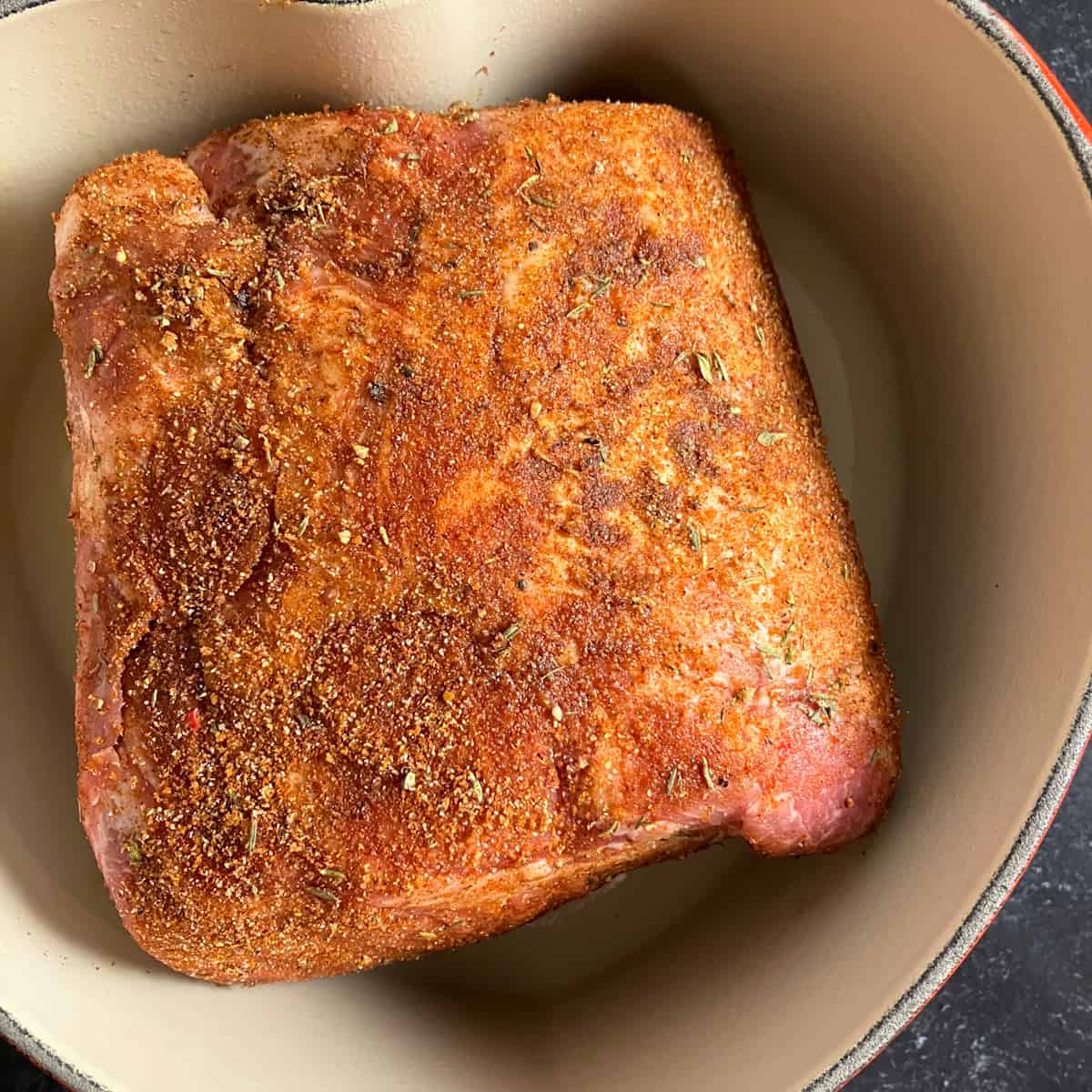
Bake the pork roast uncovered in the preheated oven at 350°F (177°C) for two hours. For even browning and to prevent one side from drying out, remember to flip the roast approximately every 45 minutes. Position your oven rack about halfway down the oven for optimal heat circulation.
After the initial baking time, begin checking the internal temperature of the pork with a reliable meat thermometer. For food safety, pork roasts should reach a minimum internal temperature of 145°F (63°C). For incredibly tender, shreddable pork, many cooks prefer to cook Boston butt to a higher temperature, typically between 195°F and 205°F (90-96°C), as this allows the connective tissues to fully break down. Add additional cooking time as needed, continuing to monitor the temperature.
Once the Boston butt reaches your desired internal temperature and is fork-tender, remove it from the oven. Tent the roast loosely with aluminum foil and allow it to rest for 10-15 minutes before slicing or pulling and serving. This resting period is crucial as it allows the juices to redistribute throughout the meat, ensuring a moist and flavorful result.
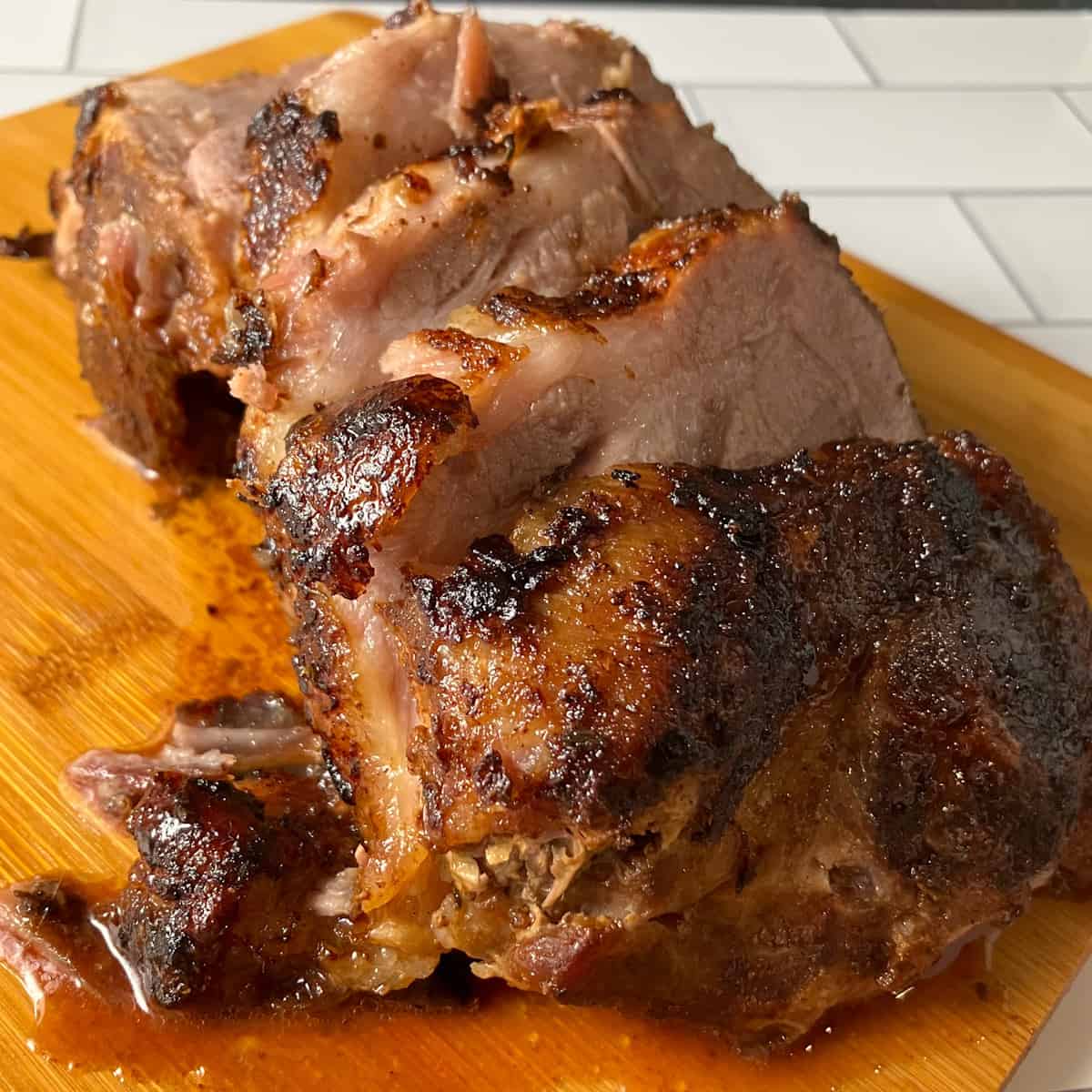
➕ How to Season a Boston Butt: Crafting the Perfect Flavor Profile
Seasoning your Boston butt is where you truly elevate its flavor, creating a delicious “bark” on the outside that many consider the best part of the roast. While a classic dry rub like the one in our recipe is fantastic, the possibilities for seasoning are endless. Experiment with different spices and flavor combinations to find your favorite:
- Classic BBQ Profile: Combine brown sugar, paprika (smoked or sweet), chili powder, garlic powder, onion powder, black pepper, and a touch of cayenne for heat.
- Herbal Infusion: Incorporate aromatic herbs like rosemary and sage for a more traditional roast flavor.
- Spicy Kick: Amp up the heat with extra cayenne pepper, crushed red pepper flakes, or even a pinch of chipotle powder for smoky spice.
- Earthy & Warm: Cumin and coriander add a deep, earthy warmth that pairs wonderfully with pork.
- Bright & Fresh: A squeeze of orange or apple juice in a marinade, or a garnish of fresh parsley after cooking, can brighten the flavor.
- Celery Seed: Often overlooked, celery seed adds a unique, savory depth to pork rubs.
- Pre-made BBQ Spices: For convenience, a quality pre-made BBQ spice blend can offer a complex flavor profile without needing to measure individual spices.
Consider whether you prefer a dry rub, applied directly to the meat before cooking, or a marinade, which can penetrate deeper into the muscle fibers over several hours or overnight. Both methods offer distinct advantages in flavoring your pork shoulder.

🥘 Essential Ingredients for Your Boston Butt Pork Roast Recipe
To create this incredibly delicious cooked Boston butt roast, you’ll need a few key ingredients for both the pork and its savory dry rub:
- Boston Butt: A 2-pound (approximately 907 grams) boneless Boston butt is ideal for this recipe, offering a manageable size for oven roasting and serving 4 people generously.
- Brown Sugar: 1½ teaspoons. This adds a touch of sweetness and helps create that desirable caramelized crust. For a keto-friendly option, you can substitute with Swerve or another erythritol-based sweetener.
- Chili Powder: ½ teaspoon. Provides a mild, savory, and slightly smoky flavor.
- Paprika: ½ teaspoon. Opt for smoked paprika if you want to infuse a deeper, smoky essence into your roast. Sweet paprika works well too.
- Dried Thyme: ¼ teaspoon. Adds an aromatic, earthy note that complements pork beautifully.
- Garlic Powder: ¼ teaspoon. Essential for a savory flavor base.
- Onion Powder: ¼ teaspoon. Provides a concentrated onion flavor without the moisture of fresh onion.
- Salt and Black Pepper: To taste. These fundamental seasonings bring out all the other flavors. Adjust according to your preference.
- Cooking Oil Spray: Of your choice, for preventing the pork from sticking to the pan.
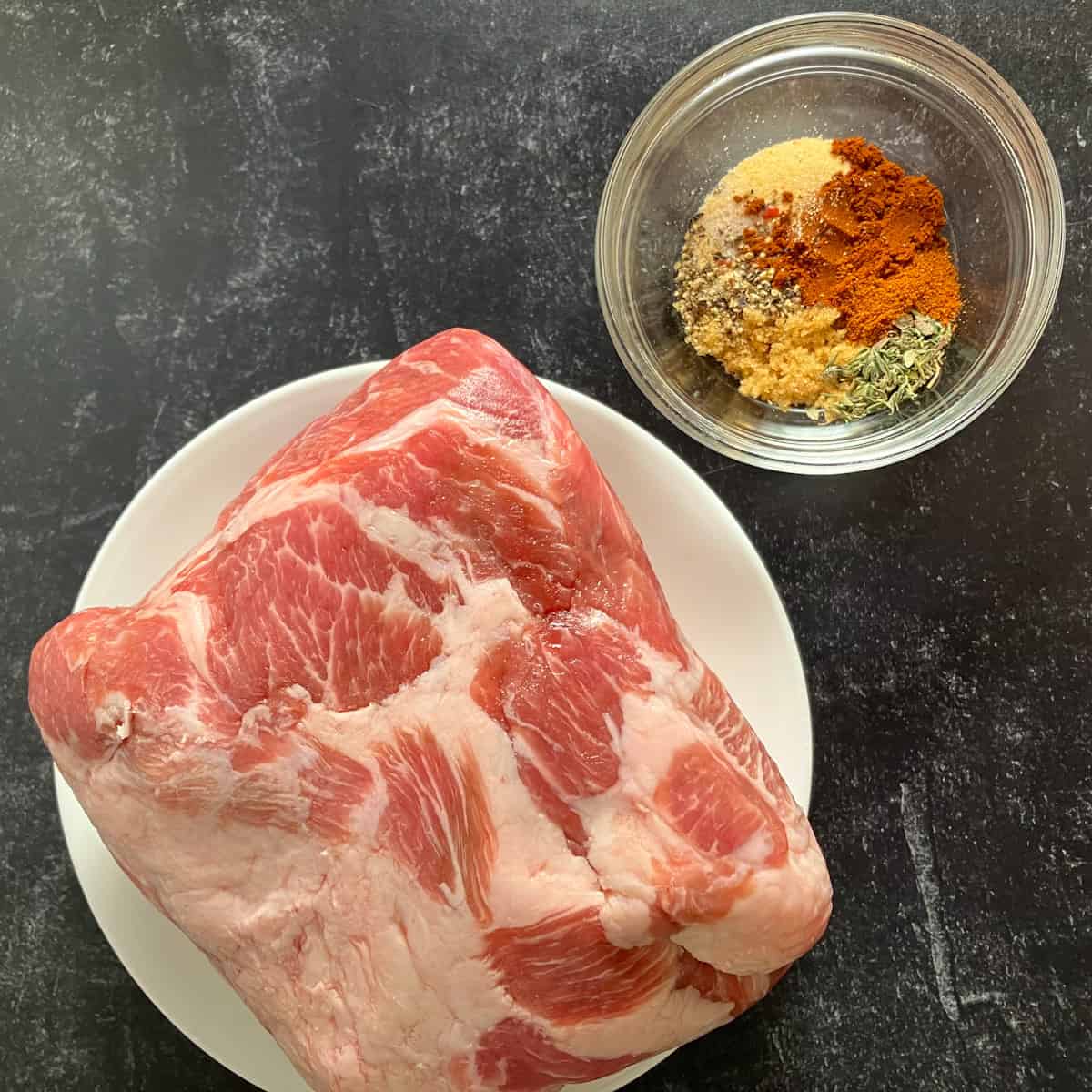
In addition to these ingredients, you’ll also need some basic kitchen equipment:
- A small enameled cast iron Dutch oven or a heavy-bottomed roasting pan.
- Aluminum foil for resting the roast.
- A reliable meat thermometer to ensure perfect doneness.
❓ Where to Buy Boston Butt: Tips for Sourcing Your Pork Shoulder
Finding Boston butt for sale is generally quite easy in the US, as it’s a popular and widely available cut. You can typically locate it at most major grocery stores in the meat section. Look for cuts labeled “Boston butt,” “pork butt,” or “pork shoulder.”
If you’re seeking specific qualities, such as grass-fed or pasture-raised pork, you might explore specialty butchers or online retailers. For example, the pork butt used in the original recipe was sourced from Thrive Market. Other excellent online options include US Wellness Meats, where you can find quality pork shoulder here, or even on Amazon for convenient delivery.
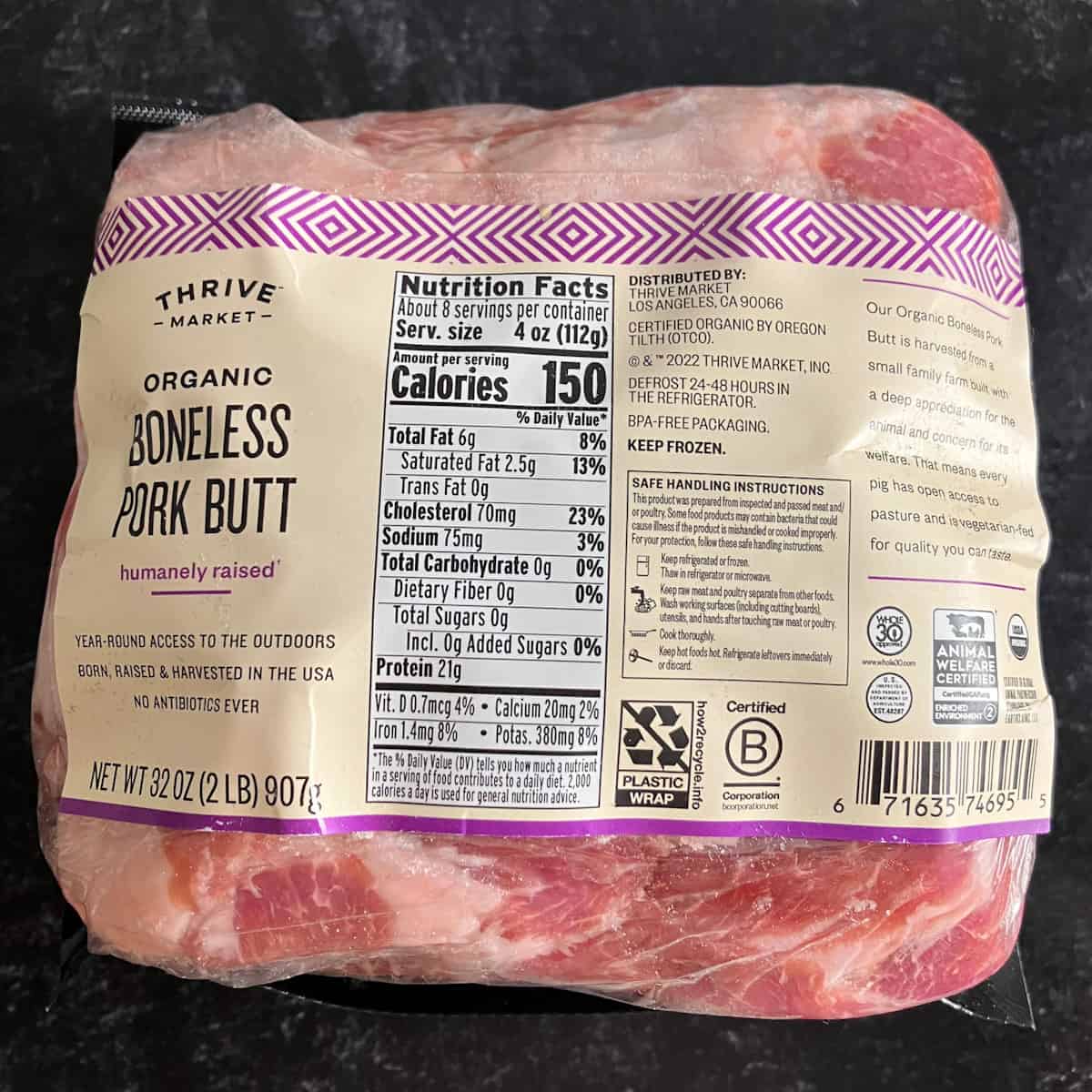
The Boston butt price per pound can vary significantly depending on the retailer, quality, and whether it’s on sale, ranging from under $2 to over $10. For the most budget-friendly options, consider checking your local warehouse clubs like Costco and Sam’s Club. These stores often offer larger, bone-in pork Boston butts at competitive prices, making them excellent choices for feeding a crowd or for meal prepping. For instance, at the time of writing, Sam’s Club was offering bone-in pork Boston butt for around $1.98 per pound, demonstrating the potential for significant savings.
🥗 How to Serve Boston Butt Pork Roast: Versatile Side Dishes
This delectable Boston butt recipe serves as a robust and protein-rich main dish, pairing beautifully with a wide array of vegetables and starches. The tender, flavorful pork makes it a versatile centerpiece for any meal. Here are some inspiring ideas for side dishes that complement Boston butt perfectly:
- Classic Comfort: Creamy mashed potatoes or fluffy baked potatoes are always a hit, soaking up all the delicious pan juices.
- Hearty Breads: Serve with a side of Air Fryer Cornbread, which adds a comforting and slightly sweet contrast. Warm dinner rolls or crusty bread are also excellent for dipping.
- Roasted Vegetables: Roasted root vegetables like carrots, parsnips, or sweet potatoes add sweetness and texture. Or try simple Air Fryer Frozen Vegetables for a quick and healthy option.
- Green Sides: A fresh green salad with a vinaigrette dressing provides a refreshing counterpoint to the rich pork. Sautéed green beans with garlic or steamed asparagus (Canned Asparagus Recipe) are also great choices.
- Pasta & Grains: Creamy Costco Mac and Cheese or a simple rice pilaf can make the meal more substantial and satisfying.
- Southern Flair: For a Southern-inspired meal, consider serving with collard greens, black-eyed peas, or coleslaw.

No matter your preference, the rich flavor of pork Boston butt allows it to pair well with a wide variety of accompaniments, making it a versatile choice for any meal planning.
😋 Creative Boston Butt Recipes: Maximizing Your Leftovers
Don’t let any of your delicious pork butt roast go to waste! Leftover Boston butt is incredibly versatile and can be transformed into a variety of exciting new meals. Its tender texture and rich flavor lend themselves well to many culinary applications, making meal prep a breeze. Here are some fantastic ideas for using up your leftover Boston butt:
- Hearty Soups & Stews: Shredded pork butt adds incredible depth and substance to soups. Try adding it to a classic split pea soup or a hearty lentil stew for a comforting meal.
- Breakfast & Brunch: Dice the cooked pork and serve it alongside scrambled eggs, hash browns, or in a breakfast burrito for a savory start to your day.
- Sandwiches & Sliders: For a quick lunch or dinner, pile sliced or shredded pork onto buns for a simple, satisfying “ham” sandwich. Add a dollop of your favorite BBQ sauce for delicious sliders.
- Mexican-Inspired Dishes: Shredded pork is perfect for tacos, burritos, fajitas, or quesadillas. The rich flavor pairs wonderfully with fresh salsa, avocado, and a squeeze of lime.
- Salad Topping: For a lighter meal, chop the cooked pork and use it as a flavorful protein topping for a fresh green salad. Add some roasted vegetables and a zesty dressing.
- Pizza Topping: Get creative and add some diced or shredded pork butt to your homemade pizza, perhaps with a smoky BBQ sauce base instead of tomato.
And if you’re looking for different methods to cook Boston butt from scratch, be sure to check out the frequently asked questions below for more inspiration!
🌡️ Boston Butt Internal Temperature for Perfect Doneness
Achieving the correct internal temperature is crucial for both food safety and the desired texture of your Boston butt. According to the USDA, raw pork, including Boston butt, should be cooked to a minimum internal temperature of at least 145°F (63°C). Once this temperature is reached, the pork roast should be allowed to rest for at least 3 minutes before slicing and serving. This resting period is vital for the juices to redistribute, ensuring a tender and moist final product.
However, for that fall-apart, shreddable texture often desired for pulled pork, you’ll want to cook your pork shoulder beyond the minimum safe temperature. For pulled pork, aim for an internal temperature between 195°F and 205°F (90-96°C). At these higher temperatures, the connective tissues (collagen) in the meat break down into gelatin, resulting in that incredibly tender, juicy texture perfect for pulling apart with forks. Always use a reliable meat thermometer inserted into the thickest part of the roast, avoiding any bones, to get an accurate reading.
🥶 How to Freeze Boston Butt Leftovers: Storage and Reheating Tips
One of the many benefits of cooking a delicious Boston butt is the potential for wonderful leftovers. Cooked pork butt freezes and reheats beautifully, making it an excellent candidate for meal prepping. Any leftover Boston butt that you don’t plan to consume within 3-4 days should be moved from the refrigerator to the freezer to maintain its quality and safety.
To freeze, ensure the pork is completely cooled first. Then, portion the leftovers into meal-sized servings. Store them in airtight containers, vacuum-sealed bags, or high-quality freezer bags with as much air pressed out as possible. This helps prevent freezer burn and preserves the meat’s flavor and texture for up to 2-3 months.
When you’re ready to enjoy your frozen leftovers, reheating is simple:
- Air Fryer: For crispy edges and a quick reheat, place slices or chunks of Boston butt in an air fryer at 400°F (200°C) for 3-5 minutes, or until heated through.
- Microwave: For a convenient option, reheat pork roast slices in a microwave on high for 1-2 minutes, checking at 30-second intervals until warmed.
- Oven: For larger quantities or to prevent drying, reheat in a preheated oven at 300°F (150°C), covered with foil, until heated through (about 15-20 minutes). Adding a splash of broth or water can help keep it moist.
- Stovetop: For shredded pork, gently reheat in a skillet over medium-low heat with a little broth or BBQ sauce to maintain moisture.
Properly stored and reheated, your leftover Boston butt will taste nearly as good as the day it was made, providing delicious meals for days to come.
📋 Boston Butt Calories and Nutrition Information
Understanding the nutritional profile of Boston butt can help you incorporate it into your diet. This cut of pork is known for being rich in flavor and tender, making it a popular choice. Here is an estimated nutrition information for ¼ of the Boston Butt recipe (based on a 2lb roast cooked as directed):
- Calories: 309 kcal
- Total Fat: 12.1g (though some fat renders off during cooking)
- Saturated Fat: 4g
- Cholesterol: 130mg
- Sodium: 160mg (this can vary significantly based on the amount of salt added in seasoning)
- Total Carbohydrate: 2.2g
- Fiber: 0.3g
- Sugar: 1.6g
- Protein: 42.2g
- Vitamin A: 9.6% DV (Daily Value)
- Vitamin C: 0% DV
- Calcium: 0% DV
- Iron: 17.3% DV
Boston butt is naturally a low-carb, keto-friendly, dairy-free, and gluten-free food, making it suitable for various dietary preferences. It’s an excellent source of high-quality protein, essential for muscle repair and growth, and is also rich in a variety of B-complex vitamins (such as B1, B6, B12), which are vital for energy metabolism. Additionally, it provides a good amount of iron, crucial for oxygen transport in the blood. While it is a higher-fat cut compared to leaner options like pork tenderloin, much of the fat does render off during the slow cooking process, contributing to its incredible moisture and flavor. Enjoy this robust and nutritious cut as part of a balanced diet.
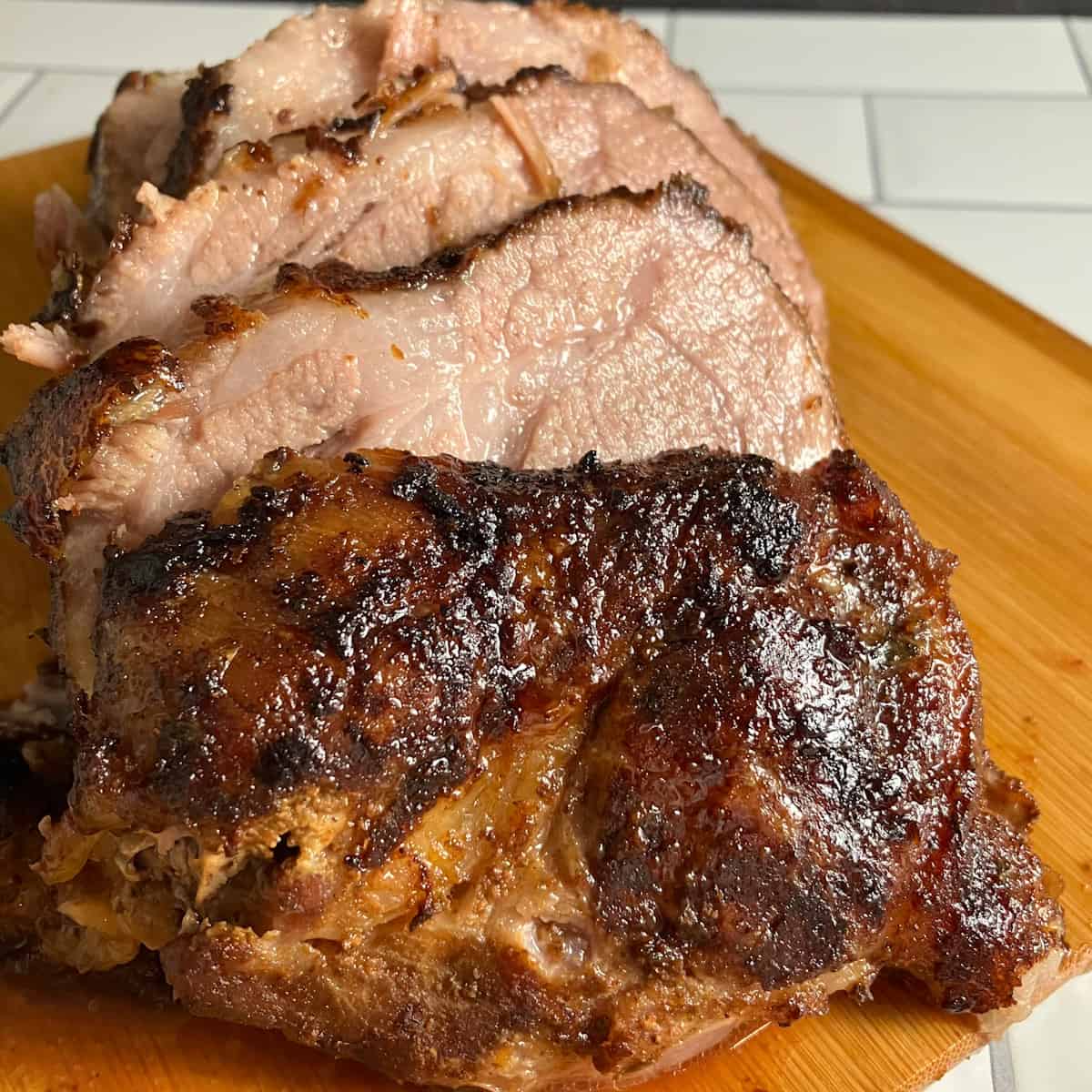
FAQs: Your Boston Butt Questions Answered
How to Smoke a Boston Butt? Achieving Authentic BBQ Flavor
Smoking a Boston butt is the quintessential method for achieving that classic, tender, and smoky pulled pork. The process typically involves low and slow cooking over indirect heat with wood smoke. How long to smoke Boston butt? Smoking times vary greatly depending on the size of the roast and your smoker’s temperature, but it’s generally a long process. A common guideline is to smoke for 1.5 to 2 hours per pound. For instance, this recipe for smoker Boston butt, using apple cider vinegar and a Memphis-style rub, suggests smoking for approximately 6 hours for a smaller cut. The ideal temperature range for smoking pork butt is typically between 225-275°F (107-135°C), allowing for ample smoke penetration and fat rendering. Don’t forget to serve your perfectly smoked pork with classic accompaniments like creamy coleslaw, tangy barbecue sauce, and soft buns for the ultimate BBQ experience!
How to Pull Pork Boston Butt? Techniques for Tender Shredded Pork
The magic of a perfectly cooked Boston butt often culminates in its ability to be “pulled” into succulent, shredded strands. For the best results, especially when aiming for pulled pork, a slow-cooked method (like in a crockpot or smoker) is highly recommended, as it ensures maximum tenderness. To pull Boston butt, once it’s cooked to an internal temperature of 195-205°F (90-96°C) and has rested sufficiently, transfer the hot roast to a sturdy cutting board. Then, using two forks, specialized meat claws, or heat-resistant BBQ gloves, begin to shred the pork apart. The meat should be so tender that it easily separates into juicy, flavorful strands, ready to be mixed with your favorite barbecue sauce or served as is.
How to Slow Cook Pork Butt? Effortless Crock Pot Perfection
For an incredibly convenient and hands-off approach to cooking Boston butt, the slow cooker (or crockpot) is your best friend. Learning how to cook Boston butt in a crock pot slow cooker yields consistently tender and juicy results with minimal effort. The moist, low-heat environment of a slow cooker is perfect for breaking down the connective tissues in pork shoulder, making it ideal for pulled pork. You can find a fantastic recipe for slow-cooked pork butt in my pulled pork bowls recipe. These bowls are not only incredibly tasty but also happen to be low-carb, offering a healthy and flavorful meal option!
How to Cook Boston Butt on a Gas Grill? Indirect Heat Method
Yes, you can absolutely cook a delicious Boston butt on a gas grill! The key is to utilize an indirect heat method, mimicking the low and slow environment of a smoker or oven. This involves setting up your grill so that the heat source is not directly beneath the pork. For example, you might turn on burners on one side of the grill while placing the pork on the unlit side. Maintain a consistent grill temperature of around 225-275°F (107-135°C). Here is a highly-rated recipe for grilling Boston butt on a gas grill, demonstrating how surprisingly easy it can be. There’s no complex brining or marinating required to achieve tender and flavorful results; simple dry rubs work beautifully with this method.
How to Cook Boston Butt on a Pellet Grill? The Traeger Method
For those who own a pellet grill, cooking Boston butt is a fantastic way to utilize its ability to maintain precise temperatures and infuse incredible smoky flavor. Pellet grills, like Traeger, make the “low and slow” cooking method incredibly easy and consistent. A popular approach involves a simple recipe that highlights the natural flavors of the pork with a hint of applewood smoke. Traeger offers an excellent recipe for smoked pulled pork, which you can find here. Typically, you only need three simple ingredients: the Boston butt, a spritz of apple cider for moisture, and your favorite BBQ sauce to finish. The pellet grill handles the smoke and temperature control, delivering a tender and flavorful pulled pork with minimal fuss.
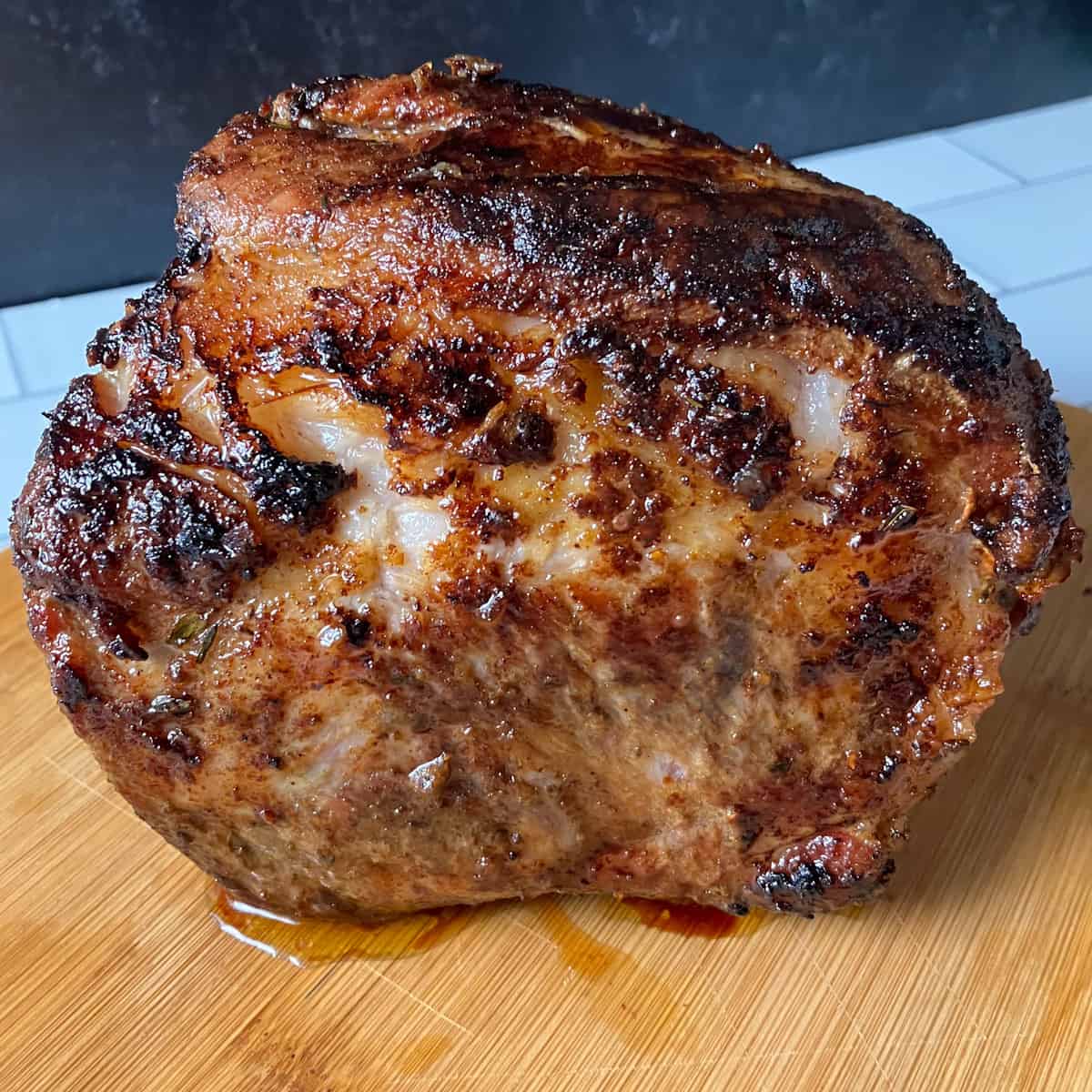
👩🏻🍳 More Delicious Pork Recipes to Explore
If you’ve enjoyed mastering the Boston butt and are looking for more incredible pork dinner recipes, you’re in luck! Pork is an incredibly versatile meat, offering a wide range of flavors and textures depending on the cut and cooking method. Expand your culinary repertoire with these other fantastic pork dishes:
- Air Fryer Pork Roast: A quicker way to get tender, juicy pork with a crispy exterior.
- Ham Shank Recipe: Perfect for a slow-cooked, rich, and savory meal.
- Pork Belly Air Fryer Recipe: Achieve irresistible crispy pork belly with ease.
- Chorizo Recipe: Learn to make your own fresh, homemade Mexican chorizo sausage.
- Air Fryer Bacon-Wrapped Pork Tenderloin: A lean and elegant dish, made even better with the added flavor of bacon.
Each of these recipes offers a unique way to enjoy pork, proving just how diverse and delicious this protein can be in your home kitchen!
Boston Butt Pork Roast Recipe (How to Cook Boston Butts)
By Summer Yule
Print Recipe
Pin Recipe
2 hours
2 hours
Dinner
American
4
309
kcal
Ingredients
-
2
lbs.
Boston butt
(907 grams, boneless) -
1½
teaspoons
brown sugar -
½
teaspoon
chili powder -
½
teaspoon
paprika -
¼
teaspoon
dried thyme -
¼
teaspoon
garlic powder
-
¼
teaspoon
onion powder - salt and pepper, to taste
- cooking oil spray of choice
Love this recipe?
Please leave a comment below 😊
Instructions
- Preheat the oven to 350°F (177°C).
- In a small bowl, mix brown sugar, chili powder, paprika, thyme, garlic powder, onion powder, salt, and pepper. Rub this dry rub on all sides of the Boston butt.
- Spray a small, enameled Dutch oven with cooking spray. Place the pork in the pot.
- Bake uncovered at 350°F for two hours, flipping every 45 minutes. Use a rack about ½ way down in the oven.
- Check the internal temp with a meat thermometer. Pork roasts should reach a safe minimum internal temperature of 145°F (63°C). Add additional cooking time if needed.
- When done cooking, tent the Boston butt in aluminum foil and let it rest 10-15 minutes before slicing and serving.
Equipment
- Small Dutch Oven
- Foil
- Kitchen Thermometer
Notes
💭 Expert Tips from Dietitian Summer Yule
This is a level 3 recipe (weight maintenance and active lifestyles). Is Boston butt healthy? Boston butt is a fatty cut of pork that is high in calories, but it also provides a variety of essential vitamins and minerals. If you’re looking for a heart-healthy meat or one that’s better for weight loss, Boston butt is not your best bet due to its higher fat content.
Pork butt is not a lean cut of pork like pork tenderloin. For a low-fat and low-calorie pork dish, consider making a pork tenderloin recipe, like this air fryer stir fry.
The nice thing about Boston butt is that its high fat content makes it less likely to dry out compared to leaner pork cuts. Boston butt tends to stay wonderfully juicy and moist, even if you accidentally overcook it a bit. Its amazingly delicious flavor tends to make it a crowd-pleaser, even among picky eaters, ensuring a satisfying meal.
Nutrition information is for ¼ of the Boston butt roast, based on a 2-pound roast.
nutrition info disclaimer
All recipes on this website may or may not be appropriate for you, depending on your medical needs and personal preferences. Consult with a registered dietitian or your physician if you need help determining the dietary pattern that may be best for you.
The nutrition information is an estimate provided as a courtesy. It will differ depending on the specific brands and ingredients that you use. Calorie information on food labels may be inaccurate, so please don’t sweat the numbers too much.
“To taste” means to your preferences, which may have to be visual to follow food safety rules. Please don’t eat undercooked food x
Nutrition
Calories:
309
kcal
Carbohydrates:
2.2
g
Protein:
42.2
g
Fat:
12.1
g
Saturated Fat:
4
g
Fiber:
0.3
g
Added Sugar:
1.6
g
Vitamin A:
9.6
% DV
Iron:
17.3
% DV
boston butt, boston butt recipe, boston butt roast, boston pork butt, cook boston butt, how to cook boston butt, pork boston butt, pork butt, pork butt recipe, recipe for boston butt, recipe for pork butt
Shop our cookbook!
Easy Air Fryer Recipes for One
Burning your air fryer recipes?
Here’s how to fix it!
Join our community! Subscribe for all of the latest and greatest recipes, and follow me on Facebook, Pinterest, Instagram, and YouTube!

